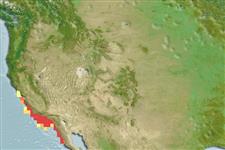Environment: milieu / climate zone / depth range / distribution range
Écologie
marin démersal; profondeur 0 - 302 m (Ref. 6793). Subtropical; 39°N - 30°N, 123°W - 115°W
Eastern Pacific: San Francisco, California, USA to Cape San Quintin, Baja California, Mexico.
Length at first maturity / Taille / Poids / Âge
Maturity: Lm 34.0, range 29 - ? cm
Max length : 51.0 cm TL mâle / non sexé; (Ref. 2850); poids max. publié: 1.5 kg (Ref. 40637); âge max. reporté: 18 années (Ref. 39277)
Inhabit rocky areas. Reported to reach 64 cm, but specimens over 51 cm may have been the redbanded rockfish, Sebastes babcocki. Viviparous (Ref. 34817).
Life cycle and mating behavior
Maturité | Reproduction | Frai | Œufs | Fécondité | Larves
Eschmeyer, W.N., E.S. Herald and H. Hammann, 1983. A field guide to Pacific coast fishes of North America. Boston (MA, USA): Houghton Mifflin Company. xii+336 p. (Ref. 2850)
Statut dans la liste rouge de l'IUCN (Ref. 130435)
Menace pour l'homme
Harmless
Utilisations par l'homme
Plus d'informations
RéférencesAquacultureProfil d'aquacultureSouchesGénétiqueElectrophoresesHéritabilitéPathologiesTraitementNutrientsMass conversion
CollaborateursImagesStamps, Coins Misc.SonsCiguateraVitesseType de nageSurface branchialeOtolithesCerveauxVision
Outils
Articles particuliers
Télécharger en XML
Sources Internet
Estimates based on models
Preferred temperature (Ref.
123201): 9.7 - 11.9, mean 9.9 °C (based on 5 cells).
Phylogenetic diversity index (Ref.
82804): PD
50 = 0.5000 [Uniqueness, from 0.5 = low to 2.0 = high].
Bayesian length-weight: a=0.01122 (0.00680 - 0.01852), b=3.03 (2.89 - 3.17), in cm total length, based on LWR estimates for this species & Genus-body shape (Ref.
93245).
Niveau trophique (Ref.
69278): 3.7 ±0.5 se; based on size and trophs of closest relatives
Résilience (Ref.
120179): Faible, temps minimum de doublement de population : 4,5 à 14 années (tmax=18).
Fishing Vulnerability (Ref.
59153): Moderate vulnerability (40 of 100).
